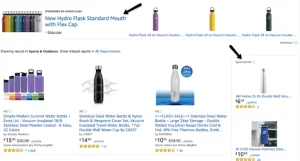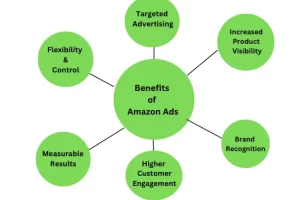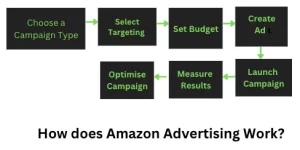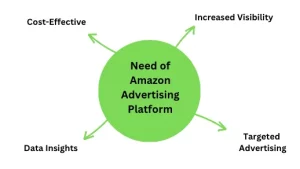Guide to Amazon ad 2024
In 2022, Amazon reported 37.7 billion US dollars revenue generated through amazon ad.
- Amazon will account for 10.2% of global digital ad spending in 2023.
- With over 300 million active users worldwide, Amazon is the largest online marketplace, making it a prime platform for businesses of all sizes to advertise their products and reach potential customers.
Let’s read the guide to learn how to advertise on Amazon.
What are Amazon Ads?
Amazon Ads is an advertising platform that allows sellers and vendors on Amazon to promote their products to a larger audience. Ads can be displayed in various locations across Amazon’s website, including search results pages and product detail pages.

Multiple Amazon Ad formats exist, such as Sponsored Products, Sponsored Brands, and Sponsored Displays. These ads can target specific audiences based on search terms, product categories, and customer behaviour.
Amazon Ads aims to increase product visibility, attract more customers, and drive more sales for sellers on the platform.
Read: Details on amazon advertising.
Benefits of Amazon Ad
Here are some benefits of Amazon Ads:

- Targeted advertising: Amazon Ads allow for targeted advertising based on search terms, product categories, and customer behaviour, allowing sellers to reach audiences more likely to convert.
- Increased product visibility: Amazon Ads can help your products appear in front of a wider audience, increasing the chances of discovery and ultimately leading to more sales.
- Improved brand recognition: Sponsored Brands on Amazon can help increase brand awareness and recognition among potential customers.
- Enhanced customer engagement: Amazon Ads can help sellers engage with potential customers by showcasing their products visually appealingly and providing helpful information such as ratings and reviews.
- Measurable results: Amazon’s advertising platform offers various tools and metrics to track the performance of your ads and adjust your strategy accordingly, allowing for a higher return on investment.
- Flexibility and control: Amazon Ads allow for flexibility and control over ad spend, allowing sellers to set budgets and adjust their strategy as needed.
How does Advertising on Amazon Work?
This is how Amazon advertising work for brands:

- Choose a Campaign Type: Before you start working on Amazon, you must select from several campaign types. Some of the types include Sponsored Products, Sponsored Brands, Sponsored Displays, and Sponsored Videos.
- Select Targeting Options:Target your ads based on keywords, products, interests, behaviours, and demographics.
- Set Your Budget: You can set a daily or lifetime budget for your campaign.
- Create Your Ad: Create an ad with a headline, product image, and copy.
- Launch Your Campaign: Once you’ve created your ad and selected your targeting options and budget, you can launch your campaign.
- Measure Results:Monitor your campaign’s performance using Amazon’s reporting tools. You must know the click-through rate (CTR), and your total spend.
- Optimise Your Campaign:Make the best of your targeting via ad creative and adjust the budget.
Overview of Amazon Advertising Platform
Advertising on Amazon can be a powerful way to reach millions of shoppers looking to buy products.
By advertising on Amazon, businesses can increase brand exposure, reach more customers, and drive sales and revenue. Amazon’s advertising platform offers various targeting options so companies can reach their ideal customers based on search terms, interests, and behaviors.
Amazon’s reporting tools also provide valuable insights into campaign performance so businesses can make data-driven decisions and optimize their advertising strategy for better results.This makes Amazon all the more relevant.
Let us read the reasons in detail below.
Importance of Amazon Advertising Platform for Business
The Amazon advertising platform is an important tool for businesses looking to sell their products on the world’s largest online marketplace. Here are a few reasons why you need Amazon Advertising Platform:

- Massive reach: Amazon has over 300 million active users worldwide, making it the largest online marketplace. Advertising on Amazon allows businesses to reach a large and diverse audience of shoppers actively looking to buy products.
- Precise targeting: Amazon’s advertising platform offers various targeting options, allowing businesses to reach their ideal customers based on search terms, interests, and behaviours. This helps companies to ensure that their ads are seen by the people who are most likely to be interested in what they have to offer.
- Measurable results: Amazon’s reporting tools provide valuable insights into campaign performance, so businesses can track their results and make data-driven decisions to optimize their strategy. This helps businesses get the most out of their advertising budget.
- Increased visibility: Advertising on Amazon can help businesses increase their brand awareness and product visibility. When shoppers see a business’s ads on Amazon, they are more likely to remember the brand and consider buying its products when they are ready to make a purchase.
- Boosted sales: Ultimately, the goal of advertising is to drive sales. Amazon’s advertising platform can help businesses achieve this goal by reaching more customers, increasing brand awareness, and making their products more visible.
Understanding Amazon’s Advertising Platform
- Amazon’s massive user base makes it an ideal platform for businesses to reach their target audience.
- Companies that want to succeed on Amazon must understand its advertising platform.
- Amazon’s platform helps companies to make informed decisions about their advertising budget.
- Advertisers can reach their desired audience on Amazon based on search terms, interests, and behaviours.
You can know how to choose the right keywords and use targeting options effectively, businesses can ensure that their ads are being shown to the right people, increasing the likelihood of conversion and ultimately driving sales growth.
Amazon’s reporting tools provide valuable data insights into ad performance, allowing businesses to make data-driven decisions and optimise their advertising strategy for better results. The key metrics to track and how to analyse data, businesses can refine their targeting and ad messaging for maximum impact.
Explanation of different types of ads available on Amazon
Amazon offers various types of advertising options to help sellers, vendors, and brands increase their visibility and sales. Here are the most common types of ads available on Amazon:
- Sponsored Products: These ads appear in search results and product detail pages and are triggered by specific keywords. They look similar to organic listings but are marked with a “Sponsored” label. Advertisers only pay when someone clicks on their ad.
- Sponsored Brands: These ads feature a brand logo, a custom headline, and a selection of products. They appear at the top of search results and drive traffic to a brand’s or custom landing page. Advertisers pay when someone clicks on their ad.
- Sponsored Display: These ads appear on product detail pages and other Amazon pages and target shoppers based on their interests, past purchases, and browsing behaviour. They can be in the form of product recommendations, video ads, or display ads. Advertisers pay when someone clicks on or views their ad for a certain period.
- Video Ads: Short video ads appear in search results, product detail pages, and other Amazon pages. They can be in the form of sponsored product videos, brand videos, or custom videos. Advertisers pay when someone clicks on or views their ad for a certain period.
- Amazon DSP: Amazon Demand-Side Platform (DSP) is a programmatic advertising platform allowing advertisers to reach audiences on and off Amazon. Advertisers can target specific audiences, such as Amazon shoppers, and deliver display and video ads across the web. Advertisers pay for impressions or clicks.
- Stores: Amazon Stores are customizable brand pages that showcase a brand’s products and story. They allow brands to create a curated shopping experience for their customers and can be used to promote products, run promotions, and increase brand awareness. Stores are free to develop for brand owners and vendors.
With different types of ads you now know, let us further read how Amazon’s auction works.
How does Amazon’s Auction System Work?
Amazon’s advertising platform uses a pay-per-click (PPC) model, where advertisers bid for ad placement on relevant search results and product detail pages.
- The auction system determines which ads are shown and in what order, based on bid amount and relevance.
- When a shopper searches for a product, Amazon’s algorithm considers the search query and the available ad inventory to determine which ads to show. Then, it runs a real-time auction to decide which ads get displayed.
- In the auction, advertisers specify a maximum bid for each keyword or product they want to target.
- The maximum amount they’ll pay per click on their ad is the bid amount.Then, Amazon multiplies the highest bids by the advertisers’ relevance score based on factors like product title, description, and brand.
- The ad with the highest “Ad Rank” – a combination of the bid amount and relevance score – wins the auction and gets displayed.
- Importantly, advertisers only pay when a shopper clicks on their ad. The cost per click (CPC) is based on the second-highest bid plus one penny. For example, if Advertiser A bids $1 per click and Advertiser B bids $0.50 per click, Advertiser A will pay $0.51 per click. This ensures advertisers pay a fair price for their ad placement while maintaining a competitive auction.
- Amazon’s auction system aims to deliver relevant and valuable ads to shoppers while giving advertisers a fair chance to win ad placement and increase sales.
Ways To Create Effective Ads
Following is the way how to create effective ads:
- Effective ads successfully capture the target audience’s attention, communicate a clear message, and drive them to take action, such as making a purchase or signing up for a service.
- Creating effective ads on Amazon requires a combination of factors, including understanding your target audience, using relevant keywords, and creating visually appealing and informative ad content.
- Using Amazon’s different ad formats, like Sponsored Products, Sponsored Brands, and Sponsored Display, can also help you increase product visibility and reach more potential customers.
- Keep testing and improving your ad strategy to get more return on investment and drive more sales on the platform.
Read: What are effective ads?
Characteristics of Effective Ads
Here are some characteristics of effective ads:

Clear message:
Effective ads have a clear and concise message that is easy for the target audience to understand. They communicate the benefits of the advertised product or service in a way that resonates with the audience.
Eye-catching visuals:
Visuals are an important part of effective ads. They should be eye-catching and high-quality, helping grab the target audience’s attention and draw them in.
These are the best practices to create eye-catching visuals.
- Use high-quality images or videos that are visually appealing and relevant to the advertised product or service.
- Choose visually pleasing and complementary colours to the advertised product or service.
- Use simple and straightforward fonts that are easy to read and complement the overall design of the ad.
- Use contrasting colours to make the text stand out against the background.
- Use negative space effectively to make the main message stand out and avoid clutter.
- Incorporate brand elements such as logos or colours to reinforce brand identity.
- Use people or animals in the visuals to create an emotional connection with the audience.
- Use animation or movement to draw attention to the ad and make it stand out.
- Keep the design consistent with the overall brand image and messaging.
- Test different visuals to see what resonates with the target audience and optimise accordingly.
Relevance:
Effective ads are relevant to the target audience. They take into account the audience’s interests, needs, and behaviours and are designed to resonate with them personally.
Call-to-action:
Effective ads have a clear call-to-action that prompts the target audience to take action, such as making a purchase, signing up for a service, or visiting a website.
Some best practices for creating effective call-to-action (CTA) statements:
- Write clear and concise CTAs that tell users what you want them to do.
- Use strong action verbs like “buy,” “subscribe,” “register,” “download,” or “sign up.”
- Make your CTAs stand out with contrasting colors or larger fonts.
- Use urgency words like “limited time offer” or “act now” to create a sense of FOMO (fear of missing out).
- Personalize your CTAs to make them more relevant to your target audience. For example, instead of saying “start the free trial,” say “start your free trial.
- Use multiple CTAs throughout the ad to ensure the audience has numerous opportunities to take action.
- Place the CTA in a prominent location on the ad, such as near the top or bottom or in the centre of the visual.
- Use A/B testing to determine which CTAs are most effective with your target audience.
- Ensure the landing page the CTA links to is relevant to the ad and provides a straightforward and easy way to take the desired action.
Targeted:
Effective ads are targeted to the right audience. Amazon advertisers use targeting options like keywords, product categories, and audience segments to show their ads to people with the right message.
Targeting your audience on Amazon is essential for the success of your ad campaigns. Here are some ways to target your audience on Amazon:
- Keywords: Use relevant keywords in your campaigns to make sure your ads show up in search results when shoppers search for those keywords. You can use Amazon’s keyword research tool to find relevant keywords for your products.
- Product targeting: Target specific products or categories related to your products. For example, if you sell running shoes, you can target ads to appear on pages for other running gear like sports bras or athletic socks.
- Interest targeting: Target shoppers based on their interests and behaviours. Amazon tracks user behaviour and purchase history to create audience segments you can target with your ads.
- Demographic targeting: Target shoppers based on age, gender, and location. This is particularly useful if you sell products that appeal to a specific demographic, such as baby products or luxury goods.
- Remarketing: Target shoppers who have interacted with your products in the past. You can create retargeting campaigns to show ads to shoppers who have viewed your product pages or added items to their cart but still need to complete a purchase.
- Lookalike targeting: Target shoppers who are similar to your existing customers. Amazon uses data from your customer base to create a lookalike audience that you can target with your ads.
Ad Targeting-The Importance of Testing and Optimising Ads for Amazon
To test and optimise your ad targeting on Amazon, experiment with different targeting strategies, such as keywords, product categories, or audience segments. Use Amazon’s analytics tools to monitor your campaigns’ performance and identify improvement areas. Make changes to your targeting based on your analysis, and continue testing until you find the best strategies for your business.
Testing and optimising your ad targeting is crucial to the success of your advertising campaigns on Amazon. Here’s why:
- Maximises your ROI: By testing and optimising your ad targeting, you can identify the most effective targeting strategies that generate the highest return on investment (ROI). This means you can focus your ad spend on the best strategy and minimise wasted ad spend on less effective targeting.
- Improves ad relevance: Testing and optimising your ad targeting can help you improve the relevance of your ads to your target audience. This can increase shoppers’ likelihood of clicking on your ads and ultimately purchasing.
- Increases conversion rates: By identifying the most effective targeting strategies, you can increase the likelihood that shoppers who click on your ads will convert into paying customers. This can increase your conversion rates and drive more sales for your business.
- Enables continuous improvement: Testing and optimising your ad targeting is ongoing. By continually testing and refining your targeting strategies, you can continuously improve the performance of your campaigns and stay ahead of your competitors.
Testable and Optimizable:
Effective ads are continually tested and optimised to improve performance. This includes analysing data, testing different targeting strategies and ad formats, and refining the message and visuals based on audience response.
To set up an advertising campaign on Amazon, follow these steps:
- Sign in to your Amazon Advertising account: If you don’t have an account, you can create one by going to the Amazon Advertising website and clicking “Get Started.”
- Choose the type of campaign you want to create: Amazon offers several campaigns, including Sponsored Products, Sponsored Brands, Sponsored Displays, Video Ads, and Amazon DSP. Choose the type of campaign that aligns with your advertising goals.
- Set your campaign budget: Decide your daily or lifetime budget for your campaign. You can manually set your bids or use Amazon’s automated bidding system.
- Select your targeting options: Choose the keywords, products, or audiences you want to target with your ads. You can use Amazon’s targeting tools to help you find relevant keywords and products.
- Create your ad creatives: Design your ad creatives, including images, videos, and ad copy. Make sure your ad is visually appealing and aligned with your brand message.
- Set up your campaign structure: Define your ad group structure and choose the products or keywords you want to target within each ad group.
- Launch your campaign: Once you have set up your campaign, review your settings and launch your campaign. Monitor your campaign performance regularly to optimise your bids and targeting.
Measuring Success of Ad Campaigns for Amazon
Measuring the success of ad campaigns for Amazon is important because it allows sellers to understand how their ads perform and make data-driven decisions to optimise their strategy. By tracking metrics such as click-through rates, conversion rates, and return on ad spend, sellers can identify which campaigns are performing well and which may need adjustment.
This information can then be used to refine targeting, adjust bids, or optimise ad content to increase conversion chances and drive more sales. Measuring success is crucial to ensure that sellers get the most out of their advertising investment on Amazon and maximise their return on investment.
To measure success, these are the tools you can use.
Amazon’s Reporting Tools
Amazon provides several reporting tools for advertisers to track the performance of their ad campaigns. Here are some of the main reporting tools available to cut the amazon advertising cost:
- Campaign Manager: This tool allows advertisers to monitor the performance of their campaigns, ad groups, and keywords. It provides impressions, clicks, conversions, and cost-per-click (CPC) data for each campaign element.
- Sponsored Products Report: This report provides detailed information on the performance of sponsored product campaigns, including data on clicks, sales, conversion rates, and advertising cost of sales (ACOS).
- Sponsored Brands Report: This report provides data on the performance of sponsored brand campaigns, including impressions, clicks, spending, and total sales.
- Amazon Attribution: This tool provides insights into the effectiveness of off-Amazon marketing campaigns. It allows advertisers to track and analyse the impact of their campaigns on Amazon sales and revenue.
- Brand Analytics: This tool provides insights into customer behaviour on Amazon, including search terms, purchase behaviour, and competitor performance. It helps advertisers to better understand their target audience and improve their ad targeting strategies.
- Advertising API: This tool allows advertisers to access and integrate Amazon advertising data into their reporting tools or systems.
Key Metrics To Track For Measuring Ad Success
Here are some key metrics to track for measuring ad success:

- Click-through rate (CTR) measures how many people click on your ad after seeing it. A higher CTR means your ad is resonating with your target audience.
- After clicking on your ad, the conversion rate measures the percentage of people who take a desired action, such as making a purchase or filling out a form. A higher conversion rate means your ad drives people to take your desired steps.
- Cost-per-click (CPC) measures the average cost of each click on your ad. A higher conversion rate indicates that your ad is effectively driving desired actions.
- Cost-per-Click (CPC): This measures the average cost per click on your ad. Lower CPCs indicate that your ad is performing well and driving clicks at a lower cost.
- Return on Ad Spend (ROAS): This measures the revenue generated from your ad campaigns compared to the cost of running the campaigns. A higher ROAS indicates that your ad campaigns create more revenue than they cost.
- Impressions: This measures the number of times your ad was shown to potential customers. Higher impressions can lead to higher CTRs and, ultimately, higher conversions.
- Engagement: This measures the level of interaction with your ads, such as likes, shares, and comments. Higher engagement indicates that your ad resonates with your target audience and generates interest.
- Customer Lifetime Value (CLV): This measures a customer’s total value over their relationship with your brand. By tracking CLV, you can better understand the long-term impact of your ad campaigns on your business.
Tips for Analysing Data and Making Data-Driven Decisions
Here are some tips for analysing data and making data-driven decisions:
- Define clear objectives: It is important to define clear objectives and goals before analysing data. This will help ensure the analysis is focused and relevant to the business needs.
- Collect relevant data: Ensure the analysed data is relevant to the defined objectives and goals. Collect data from reliable sources and make sure the data is accurate and up-to-date.
- Use the right tools: Choose the right tools and software to analyse the data. Use tools capable of handling large datasets with the necessary features to provide insights and visualisation.
- Clean the data: Clean and prepare the data before analysing it. This involves removing duplicates, correcting errors, and formatting the data for analysis.
- Identify trends and patterns: Use data visualisation techniques to identify trends and practices in the data. This can help uncover insights and opportunities for improvement.
- Test hypotheses: Develop hypotheses based on the data and test them using statistical analysis. This can help validate assumptions and identify cause-and-effect relationships.
- Make data-driven decisions: Use insights and analysis to make informed decisions. Communicate the findings to stakeholders and make decisions based on the data rather than intuition or assumptions.
- Continuously monitor and optimise: Use ongoing analysis to monitor performance and identify opportunities for optimization. This can help ensure that decisions are data-driven and that the business is constantly improving.
Advanced Ad Strategies on Amazon
Using advanced ad strategies on Amazon can help increase product visibility, attract more customers, and ultimately drive more sales, making it a valuable investment for sellers looking to maximise their profits on the platform.
Use Sponsored Brands and Sponsored Display ads
Using Sponsored Brands and Sponsored Display ads on Amazon can offer several benefits for sellers, such as increasing brand awareness, driving more traffic to product pages, and ultimately increasing sales.
Sponsored Brands can also help with brand recognition, while Sponsored Display ads can help with product discovery and retargeting potential customers.
Leverage Amazon’s Remarketing Capabilities
Leveraging Amazon’s ad remarketing capabilities can be a powerful way for sellers to reach potential customers who have previously interacted with their products. By retargeting these individuals with relevant ads, sellers can increase the chances of conversion and ultimately drive more sales.
Amazon’s remarketing capabilities can also help sellers optimise their advertising spend by targeting audiences more likely to convert, leading to a higher return on investment.
Use Amazon’s Data To Improve Your Advertising Strategy
Use Amazon’s data to improve your advertising strategy, as it can be a valuable way for sellers to optimise their ad campaigns and increase their return on investment.
By analysing data such as customer search and purchase history, sellers can better understand their target audience’s behaviour and preferences, allowing them to create more targeted and effective ad campaigns.
Amazon’s advertising platform offers various tools and metrics to help sellers track the performance of their ads and adjust their strategy accordingly, leading to better overall results.
Conclusion:
Advertising on Amazon can be a valuable strategy for sellers looking to increase their product visibility, attract more customers, and drive more sales. By leveraging Amazon’s advanced ad strategies, remarketing capabilities, and data analysis tools, sellers can optimise their ad campaigns and increase their return on investment.
It’s important to remember that advertising on Amazon is a competitive space, and sellers should be prepared to continuously optimise their strategy to stay ahead of the competition. Nevertheless, with the right approach and resources, advertising on Amazon can be a lucrative investment for sellers of all sizes.
If you are interested to try Amazon advertisement for your brand, connect with us hello[at]noboruworld.com
FAQ
What is Amazon advertising?
Amazon advertising is a platform that allows businesses to promote their products and services on Amazon. It offers a variety of advertising options, such as sponsored products, sponsored brands, and sponsored display ads.
How does Amazon advertising work?
Amazon advertising allows businesses to bid on keywords or product categories related to their products. When a user searches for those keywords or products, the sponsored ads appear at the top of the search results or on product detail pages. Advertisers only pay when a user clicks on their ad.
How can I get started with Amazon advertising?
To start with Amazon advertising, you must create an Amazon seller or vendor account. Once you have an account, you can create campaigns and ad groups, set your budget and bids, and create ads. You can also use Amazon’s advertising tools and analytics to track the performance of your campaigns and make adjustments as needed.



